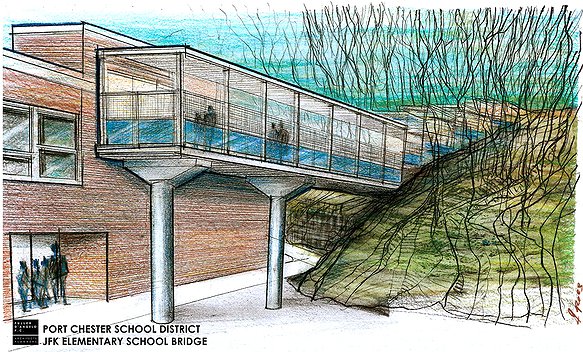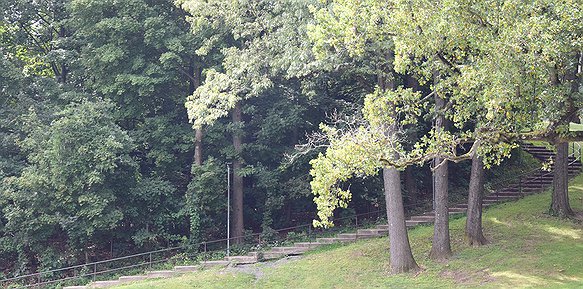Bridging the gap at JFK
August 24, 2023 at 12:04 a.m.
Unfavorable weather conditions at most schools often lead to dreary moods and alternative recess options—never a fun scenario for students and staff to manage. But John F. Kennedy Elementary School has always been uniquely impacted by harsh climate stints in more consequential ways.
The Port Chester School District’s Olivia Street campus is one school split between two buildings as the most populated of the elementary level institutions. The main building, situated at street level, houses the majority of pupils and activities, while an additional structure sits directly behind it atop a steep, flora-rich hill.
For decades, the only way to get between the buildings has been through a path that wraps around the woods.
“I don’t know exactly how long the path is, but I can tell you there’s a lot of steps involved,” chuckled John F. Kennedy School Principal Judy Diaz. She’s currently ecstatic because soon the stairway to the school’s upper haven will be much more direct.
Since essentially the day after schools went on summer break, according to Port Chester Director of Facilities Adam Rubin, the district has been at work to build a connecting bridge between the two John F. Kennedy buildings. The $2 million project has been desired for a long time but recently became possible due to federal American Rescue Plan Act funding.
All third-graders and half of the second grade attended class on the upper level of John F. Kennedy, Diaz said. However, there are several times throughout the school day where traveling between the buildings is necessary.
Pick up and drop off activities at the beginning and end of the school day happen in the main building. And while the hilltop structure has a cafeteria for lunch, students must transition to the main building for assemblies, physical education classes or to access the science room or library.
“It’s also our staff,” Diaz said. “Our staff always travel with students throughout the day; they’re never traveling on their own. And sometimes staff need to give instruction or be assigned to supervision throughout the two buildings.”
The wraparound path is unsheltered, vulnerable to all outdoor elements. Therefore, students and staff are often forced to face a stroll in the rain or snow as they’re scheduled to transition between the buildings.
And in the event of extreme weather—thunderstorms and heavy snow—students on the upper-level haven’t been authorized to transition to the main building, making them unable to access the resources it holds on those days.
The new bridge creating a direct connection was designed to address that, said Assistant Superintendent for Business Philip Silano.
“At first, we were talking about enclosing (the original path) and putting a roof over it, but then it still didn’t solve the meandering. It’s a long walk up the hill,” Silano said. “This will be a shorter run, and we think it’s going to be better.”
The bridge will serve as a covered, open walkway connecting hallways between the buildings. A series of steps and flat walkways, the passage will be covered by a flat roof with internal drainage and surrounded by fencing for security and sections of acrylic sheets to add some blockage of the elements.
Since breaking ground on the project, Rubin said construction has been relatively smooth. Though a plumbing hiccup was discovered while digging for the footings—they found a rainwater drain crossed paths with where the bridge is going—they were able to reroute the pipes and get everything back on track.
As of Monday, Aug. 21, “the footings are in, the heavy work has been done, so the construction can now start,” Silano said. “We will not be finished by the start of the school year. We’re thinking end of September or early October is where we’re at.”
For the first few weeks of the 2023-24 school year, students and staff will still need to use the original walking path up and around the hill that they’ve been utilizing for decades. Meanwhile, construction crews will continue working with a strict noise ordinance in place.
“They’ve been told no noise during the school day…we do not interrupt the educational process,” Rubin said.
“If it’s work that can be done with low disturbance, then workers will be working during the school day,” Silano added with assurance. “Anything other than that will be done off school hours, evenings and weekends.”
While the bridge won’t be ready to kick off the school year on Sept. 5, Diaz is still thrilled to see construction underway.
The project, from her perspective, has been a long time coming.
“With additional coverage, we won’t need to interrupt the instructional program. We can improve the integrity of the program,” she said. “We want our students to have access to all spaces in the building.”
“We’ve wanted this for as long as I can remember,” continued Diaz, who has worked in the building at various educational capacities for the last 18 years. “We’re really excited that it’s finally here.”






Comments:
You must login to comment.